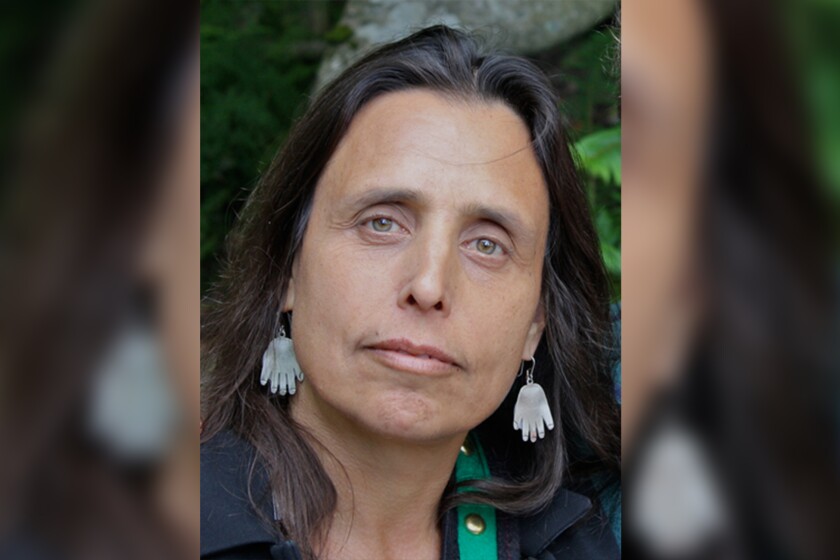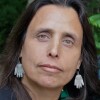The ride is hard. Oomaka Tokatakiya, the Future Generations Ride, commemorates the Lakota ancestors and families who were brutally murdered in the Wounded Knee Massacre on Dec. 29, 1890. The ancestors had ridden from Standing Rock to Pine Ridge to save their people; instead, they were shot by the Cavalry.
This year, the ride had 100 riders at the end, most of them under 20. The ride is grueling and there is suffering. That’s part of the grieving process, and the healing process. That’s the next generation.
ADVERTISEMENT
On Dec. 29, the Lakota held a ceremony at the Wounded Knee gravesite and read the names of those who were killed, and identified — aloud — women, children and entire families wiped out by the howitzers. There were many who were not named but remembered in the wind and in the moment.
It was somber. And, for the second year, clothing, moccasins, pipes that belonged to the murdered were there at Wounded Knee. They had been returned from a museum in the east, a small town in western Massachusetts, where a ghoulish collection had rested for over a century. The Barre Museum had told its patrons that the Lakota buried their clothes before they went to Wounded Knee.
We prayed, listening to songs on the cold December morning, as we looked at dresses, ghost dance shirts and baby moccasins, all stripped from the bodies. Now, all sat in open boxes on the gravesite where their people had been buried. We mourned together.
It was 1890 and the great leader Sitting Bull was incarcerated at Fort Yates with his people. The Black Hills were illegally taken with the Black Hills Act of 1877, the buffalo had been decimated. Incarcerated at prisoner-of-war camps, the rations had been cut in half. The people were starving.
On Dec. 15, the 8th Cavalry ordered the assassination of Sitting Bull by the Indian police. With his death, Sitting Bull's ally, Minneconjou Lakota leader Spotted Elk (dubbed "Big Foot" by the cavalry for the size of his shoes), fled south to the Pine Ridge Agency with about 350 mostly women and children.
They traveled under the cover of night, in the depths of winter. They rode over 200 miles through canyons, Badlands, and brutal conditions. Chased by the cavalry, they arrived at Wounded Knee, where they sought safety and a chance to live. That chance was not given.
Chief Spotted Elk surrendered just north of the village of Wounded Knee. His people camped, surrounded by the 7th Cavalry. The next morning, Spotted Elk was among the first to fall. Thirty minutes later, as many as 300 Lakota lay dead — adults, children, and even infants.
ADVERTISEMENT
Col. Forsyth commended his soldiers for their “gallant conduct … in an engagement with a band of Indians in desperate condition and crazed by religion.” The Army awarded 23 Medals of Honor to soldiers who participated in the massacre. U.S. Cpl. Paul Weinert, for instance, was cited for “firing his howitzer at several Indians in the ravine.”
Can’t really whitewash this story, although many have tried. This is not critical race theory, this is history. And, despite decades of erasure, the story is here; the people remember, and work to heal.
How do you heal? That’s a question aptly asked 133 years later. First, we acknowledge what happened, we grieve and begin to heal spiritually.
In the early 1980s, Alex White Plume's uncle told him that because the Army had not allowed survivors and family members to perform grieving ceremonies at Wounded Knee, the spirits of the victims were unable to leave the "Land of the Breathing." In 1986, White Plume, his brother Percy and 17 other Lakota, calling themselves the Si Tanka Wokiksuye Okolakiciye — "Spotted Elk Remembrance Group" — embarked on the first annual Big Foot Memorial Ride from Standing Rock to Pine Ridge.
“As men, we cried," White Plume said. "We used to try to be like the white man — don't show any pain and just be tough. But after you go through that ride, it's OK to cry. It heals your wounds." The White Plume family has continued this ride for almost 40 years; each year, new young riders come, stories and prayers are recited, men and women suffer in honor of their ancestors. And we all come to heal.
At the gravesite, I stand with Andrea Eastman, a Sisseton Dakota woman. She’s looking over the medical notes of her ancestor, Dr. Charles Eastman, who attended to survivors at what was called the Indian camp.
Eastman was among the first Native people to be certified as a European-style doctor. Eastman saved all those he could; only seven died in his care at the “Indian camp.” He was sickened by the carnage and was forced out of his position because his medical notes countered Col. Forsyth’s narrative.
ADVERTISEMENT
As I stood looking over the gravesite and the baby moccasins, I cried — we all did. There’s something that began, a new chapter in the healing from the brutality of history.
The time for massacres is long over. That’s true in North America, South America and Palestine. The time for healing is here. As I witness the horse riders, I can see a new generation coming. It is time to wipe the tears.









